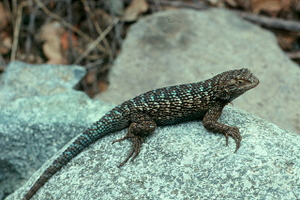These and many other lizards have a "third eye" on the top of the head. This organ--tiny but readily visible at close range--is a light receptor and is involved in the control of body temperature and daily activity rhythms.
Photo Credit: Geoffrey A. Hammerson
Sceloporus occidentalis
Common Name: western fence lizard
Animal Guild: Reptile
Class > Order > Family: Reptilia > Squamata > Iguanidae
What does the species look like?
The scales on the back are fairly large, have a ridge down the center (keeled), and are pointed. Coloration is highly variable, but often the back is gray, brown, or black, with a series of wavy dark and light bands across the back or a row of somewhat V-shaped dark blotches along each side of the back. The rear of the thigh is yellow or orange; scales on the rear of the thigh are mostly keeled. These lizards grow up to 3.9 inches (9.9 cm) in snout-vent length. Breeding males have a blue patch on the throat (sometimes partially divided, occasionally absent), a blue black-edged patch on each side of the belly (in some areas there may be a single large blue patch on the belly), sometimes blue or greenish scales on the back, a pair of enlarged scales behind the vent, and two swellings from hemipenes (copulatory organs) on the underside of the tail base. Breeding females and small young lack blue scales on the back, and the blue markings on the underside are faint or absent; they also lack enlarged scales behind the vent and have no swellings at the tail base.
Where is the species found?
States & Provinces
CA, ID, MT, NV, OR, UT, WA
Distribution
The range extends from Washington and southeastern Idaho south through Oregon, California, Nevada, and western Utah to northwestern Baja California, and disjunctly south to Isla de Cedros. Elevational range extends from sea level to about 11,000 feet (3,353 meters).
Western fence lizards live in various habitats, including grassland, sagebrush, woodland, open coniferous forest, rocky canyons, talus slopes, and fence rows. They are not found in severe deserts but do inhabit adjacent mountain slopes. They perch on the ground, on low perches (e.g., logs, fences, rocks), or high in taller bushes or trees.
General Phenology and Life History
These lizards are generally inactive during cold weather. Duration of the inactive period varies with local climate. Emergence from hibernacula occurs in late winter or early spring, depending on local conditions. Courtship and mating generally occur in spring. Egg laying extends from April or May to June or July in most areas. Eggs are buried in loose soil or secluded in old logs or under rocks. Typical clutch size varies with location and ranges from 3 to 17; clutch size tends to increase with female size, latitude, and elevation. Eggs hatch in about 2 months, mostly in August or September in many areas.
Which phenophases should I observe?
Do you see/hear...?
Activity
Individuals on land More...
For abundance, enter the number of individual animals observed in this phenophase.
Feeding For abundance, enter the number of individual animals observed in this phenophase.
Development
Young individuals For abundance, enter the number of individual animals observed in this phenophase.
Dead individuals For abundance, enter the number of individual animals observed in this phenophase.
What do these phenophases look like?
There is currently no photoguide available for this species. If you'd like help us create one, use the guidance document and species template provided here . Then send it via email to education@usanpn.org when it is complete.
